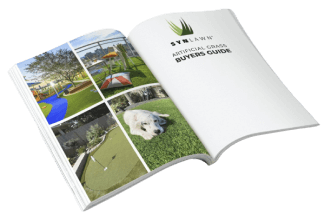Artificial lawns are an investment that more and more people are taking advantage of, especially in areas of the country that see more high-volume fluctuations in weather temperatures. Synthetic grass can withstand sweltering heat as well as downpours of rain, and rapidly dropping temperatures. Where natural lawns would fail, and brown, artificial lawns keep their gorgeous green hue no matter what the climate.
Purchasing artificial grass will save you money as opposed to the costs of watering and fertilizing a natural yard. In addition, it will save you countless hours spent working yourself into a sweat while trying (and possibly failing) to maintain a beautiful landscape in front of your home.
How Do I Maintain My Artificial Lawn?
When purchasing a synthetic lawn, you have bought a beautiful, low maintenance addition to your house; however, there are still several crucial things you need to do to retain your artificial turf maintenance. Unlike natural grass, which needs consistent water, fertilizers, pesticides, and countless hours of manual labor to maintain, synthetic lawns usually only require an occasional hosing down and a simple raking.
Taking a garden hose once a week to your artificial lawn will rinse away any dust, dirt, and debris that may be settling on the blades of grass. It will also help alleviate any potential odors that may be gathering within the lawn’s infill.
Raking your synthetic turf will break up any compacted spots within the infill, which may have begun to stick together due to heavy traffic in specific areas of your grass. If you notice places where your lawn seems to be lying flat, take a stiff-bristled brush or soft rake to that particular area. Gently brushing the blades of grass back up to their previous positions will work wonders on the overall look of your lawn. However, be careful not to use any tools with sharp metal bristles that may cause potential tearing within your synthetic grass.
Usually, a gentle rinse and an occasional brush or rake will be plenty when it comes to the care of your synthetic lawn. However, for those who have pets, or large trees and shrubs around their homes, more substantial cleaning options should be considered.
What Are Safe Cleaning Options For My Synthetic Lawn?
If you have a dog, it is a guarantee that they will enjoy your new artificial lawn just as much as you do. However, pet waste is something that should be considered when cleaning your fresh faux grass.
When your pet goes outside to use the restroom, it is recommended that you rinse out the area with a hose as soon as your time permits, and if not, you should rinse out the area which your pet uses at least once a week. Smaller dogs may not require a rush to clean up after, but some larger breeds will leave a much larger mess. Pet waste, when not cleaned up quickly, can breed bacteria in your synthetic lawn, and leave an odor that you may find difficult to remove.
If water does not seem to be doing the trick on its own when it comes to cleaning up after your pets, there are a number of options available to take the cleaning up a notch. A natural cleaning solution that is safe for your lawn would be a mixture of liquid soap and water. Adding these two things together in a spray bottle can be a simple aid in cleaning up difficult spots outside.
A second natural concoction to consider would be the one-to-one solution of distilled white vinegar and water. Both of these safe, easy to use, cleaning products could be used on your artificial grass, and then rinsed away with a hose, heeding positive results.
After you have tried your hand at soap and vinegar, but are still struggling with unwanted odor from your pets’ waste, another viable option would be the sprinkling of baking soda over the wet areas. Give the baking soda ample time to sit and absorb the odor out of the synthetic grass and infill before grabbing the hose and rinsing it away with a spray of water.
Do I Need a Commercial Cleaner for my Artificial Lawn?
If you find yourself in need of a more cleaning power beyond the above suggestions, you’ll be pleased to see that there are several turf deodorizers and cleaners on the market for synthetic lawns. These can be found online or in many home and garden improvement stores. If you do choose to shop for commercial cleaners, it is highly recommended you try to stick with options that offer natural or non-toxic components. Especially, to those whose households are made up of children and pets who may use the lawn as play areas.
The product Urine Zero, which is a natural, microbe-based turf deodorizer, which works wonders on pet smells that have gathered in carpets and artificial lawns.
It is relatively common for commercial cleaning products to cover the smell of the odor without actually removing the source. You may find yourself on a learning curve of trial and error as you try and make your way to a solution that works best for you and your synthetic grass.
How Do I Learn More?
To learn more about how to clean your artificial lawn, contact the experts at SYNLawn at (866)-796-5296. Our professionals will be more than happy to answer any questions that you may have.


